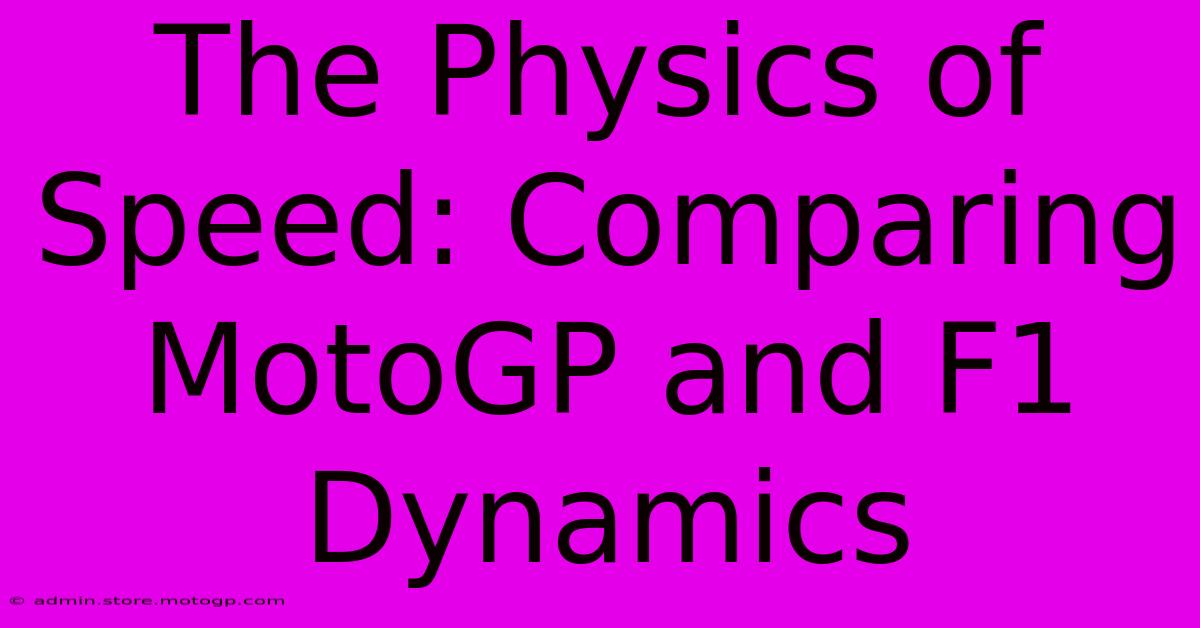The Physics Of Speed: Comparing MotoGP And F1 Dynamics

Table of Contents
The Physics of Speed: Comparing MotoGP and F1 Dynamics
The roar of the engines, the blur of speed, the precision of the drivers and riders – Formula 1 and MotoGP are pinnacles of motorsport, pushing the boundaries of engineering and human performance. But while both strive for ultimate speed, they achieve it through vastly different approaches. This article delves into the fascinating physics that underpin these contrasting disciplines, exploring the key differences in their aerodynamic designs, tire technology, and overall handling.
Aerodynamics: Downforce vs. Drag
One of the most significant distinctions lies in aerodynamics. Formula 1 cars are designed for extreme downforce, pressing them firmly onto the track at high speeds, enabling higher cornering speeds. This is achieved through complex aerodynamic elements like large front and rear wings, diffusers, and carefully sculpted bodywork. While generating immense downforce, these designs also create significant drag, hindering top speed on straights.
MotoGP bikes, conversely, prioritize a balance between downforce and minimal drag. While some downforce is beneficial for stability at high speeds and through corners, excessive drag would severely hamper their ability to achieve the blistering straight-line speeds seen in races. Their aerodynamic packages are therefore much more subtle, focusing on streamlining the rider and machine to reduce drag rather than maximizing downforce. This difference is clearly visible in the comparatively smaller wings and more streamlined bodywork of MotoGP bikes.
The Role of Airflow: A Detailed Look
The airflow around both vehicles is critical. F1 cars use sophisticated underbody aerodynamics, including carefully shaped floors and diffusers, to create a low-pressure area underneath, sucking the car towards the track. This is less emphasized in MotoGP, where the focus is on clean airflow over the rider and motorcycle to minimize drag. The rider's position also plays a crucial role in MotoGP aerodynamics, affecting airflow and overall stability.
Tire Technology: Grip and Traction
Tire technology presents another significant point of comparison. F1 cars utilize specially designed, wide, slick tires offering exceptional grip on smooth racing surfaces. The large contact patch provides immense traction, allowing for extreme cornering forces. Tire degradation and management are crucial aspects of F1 strategy.
MotoGP bikes, on the other hand, employ narrower tires with grooved treads for enhanced grip in various weather conditions. This tread pattern is essential for maintaining traction, especially when braking or accelerating. The smaller contact patch compared to F1 tires means less overall grip, requiring skilled riders to manage tire wear and traction effectively.
Tire Compounds and Strategies: A Deeper Dive
The selection of tire compounds is a strategic element in both sports. F1 teams choose from a range of compounds offering different levels of grip and durability, influencing race strategy. Similarly, MotoGP teams must consider tire choice based on track conditions, weather, and race length. The interaction between tire temperature, pressure, and track surface plays a crucial role in determining grip and performance in both disciplines.
Handling and Dynamics: Control and Stability
The handling characteristics of F1 cars and MotoGP bikes differ considerably. F1 cars are known for their precision and responsiveness, allowing drivers to make precise adjustments to their lines through corners. The high downforce enhances stability, providing a predictable platform for high-speed maneuvers.
MotoGP bikes are notoriously challenging to handle, demanding exceptional skill and physical strength from the riders. The bikes are much lighter and more agile than F1 cars, making them responsive but also prone to instability, particularly at high speeds or in unpredictable conditions. The rider must constantly adjust their body position to maintain balance and control, adding another layer of complexity to the dynamics of the sport.
Rider Skill vs. Driver Precision: The Human Factor
While both disciplines require exceptional precision and skill, the level of rider input in MotoGP is considerably higher. The inherent instability of the bikes demands constant adjustments from the rider, making human skill a critical factor in performance. In contrast, F1 cars offer greater stability, allowing drivers to focus more on strategic decisions and car setup.
Conclusion: A Tale of Two Speeds
While both Formula 1 and MotoGP push the boundaries of speed, they do so through contrasting approaches to aerodynamics, tire technology, and handling dynamics. F1 prioritizes extreme downforce for cornering speed, while MotoGP balances downforce with minimal drag for straight-line speed. The differences extend to tire technology and handling characteristics, reflecting the fundamental differences in vehicle design and the skills required to master each discipline. Ultimately, both sports are captivating demonstrations of engineering prowess and human skill, each with its own unique blend of speed and excitement.

Thank you for visiting our website wich cover about The Physics Of Speed: Comparing MotoGP And F1 Dynamics. We hope the information provided has been useful to you. Feel free to contact us if you have any questions or need further assistance. See you next time and dont miss to bookmark.
Featured Posts
-
Beyond The Microphone Moto Gp Announcers Other Talents
Feb 19, 2025
-
From Track To Garage Moto Gp Bike For Sale
Feb 19, 2025
-
Cota Parking Lot T Reserve Your Spot Today
Feb 19, 2025
-
Rare Opportunity Own A Moto Gp Machine
Feb 19, 2025
-
Moto Gp Racing Time A Glimpse Into The Future Of Racing
Feb 19, 2025
